Buy Local Day in Philly
The campaign development for a "Buy Local" campaign in Philadelphia, www.buylocalphilly.com, is moving along.
"A community’s physical form, rather than its land uses, is its most intrinsic and enduring characteristic." [Katz, EPA] This blog focuses on place and placemaking and all that makes it work--historic preservation, urban design, transportation, asset-based community development, arts & cultural development, commercial district revitalization, tourism & destination development, and quality of life advocacy--along with doses of civic engagement and good governance watchdogging.
The campaign development for a "Buy Local" campaign in Philadelphia, www.buylocalphilly.com, is moving along.
Don't forget that I am constantly adding links to the right sidebar. Partially this is to put the sites I find useful in one place. It's a sign of my "parochialism" that I put sites like the Library of Congress or the U.S. Capitol Historical Society in the "Greater" Neighborhood links section.
Otis White writes "The Urban Notebook" column for Governing Magazine and produces an e-newsletter as part of his Civic Strategies consulting practice. He wrote this today:
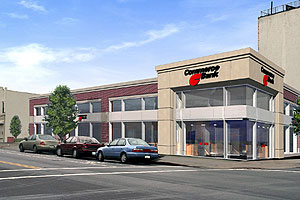

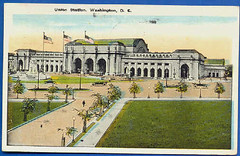
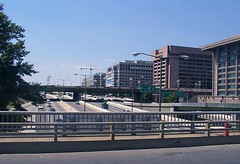
Labels: banks, civic engagement, inward suburbanization, urban design/placemaking
From the Austin Chronicle:
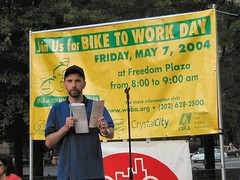 Dan Tangherlini, Director of DC's Department of Transportation, at Bike to Work Day, 2004. (Photo by Jim Hudnall.)
Dan Tangherlini, Director of DC's Department of Transportation, at Bike to Work Day, 2004. (Photo by Jim Hudnall.)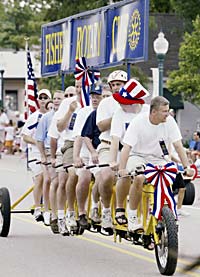 Can't we all just get along? (Photo by James.Yee@Topics.com) Imagine ten elected and appointed officials riding together on a bike such as this.
Can't we all just get along? (Photo by James.Yee@Topics.com) Imagine ten elected and appointed officials riding together on a bike such as this.Once again, Frozen Tropics keeps us informed, in "A9 Delivers "Block View" of H Street" we're alerted to the new photo feature of the Amazon A9 search service, which to compete with Google and Yahoo, is offering this and other features.
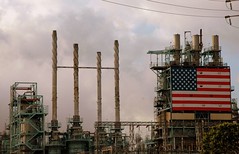 Photo from "Deep Thoughts" blog.
Photo from "Deep Thoughts" blog.Apparently, Senate Democrats in preparing an energy bill are providing for tax incentives for renewable energy.
Frankly, I think that cities need to develop incentive programs of their own, comparable to some of the programs offered by the Massachusetts Technology Collaborative, which was discussed in another blog entry earlier in the week.
Energy use is a matter of local and national import, as well as an economic competitiveness issue.
_______
For another take on the issue, check out this article, "In Portland, living the green American dream: More young urban professionals are forgoing square footage for eco-friendly homes" from the Christian Science Monitor.
In "Developer Infuses Historic Properties With Commerce," today's New York Times has an article on Anthony Lanier's upgrading of the 3300(?) block of M Street NW into "Cady's Alley", an upscale furniture and design district. All in all, it seems like a reasonably accurate article.
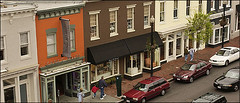 Carol T. Powers for The New York Times. Historic buildings along M Street in Washington that had fallen into disrepair have been rehabilitated and turned into elegant shops.
Carol T. Powers for The New York Times. Historic buildings along M Street in Washington that had fallen into disrepair have been rehabilitated and turned into elegant shops.
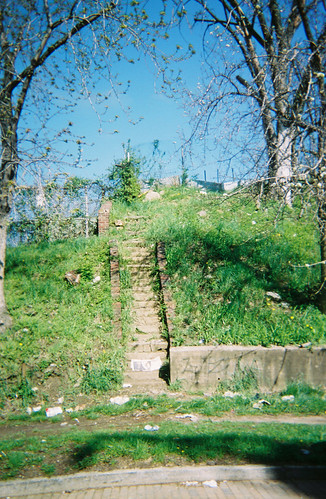 I shot this a couple weeks ago. In the HAER photo referenced in the previous entry, this side of the block is visible, and appears to be comprised of rowhouses and 3 story brick warehouses and light industrial buildings, likely drawn to the location for access to the railroad, particularly the B&O Freight Terminal in the Eckington area. I have no idea when these buildings came down. I presume it was before Ronald Cohen began assembling all but two lots on the square.
I shot this a couple weeks ago. In the HAER photo referenced in the previous entry, this side of the block is visible, and appears to be comprised of rowhouses and 3 story brick warehouses and light industrial buildings, likely drawn to the location for access to the railroad, particularly the B&O Freight Terminal in the Eckington area. I have no idea when these buildings came down. I presume it was before Ronald Cohen began assembling all but two lots on the square.
Democratic legislators join a rally against the privatization of Social Security, on Capitol Hill, Tuesday, April 26, 2005, in Washington. The venerable government program was political fodder Tuesday from the buttoned-down confines of a Senate hearing room to a boisterous outdoor rally. Democrats took on President Bush and his Social Security proposals with gusto, rebuffing pleas for bipartisanship from frustrated Republicans.(AP Photo/Manuel Balce Ceneta)
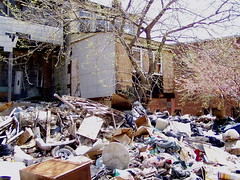 Ronald Cohen's Cherry Blossoms. Photo by Elise Bernard.
Ronald Cohen's Cherry Blossoms. Photo by Elise Bernard.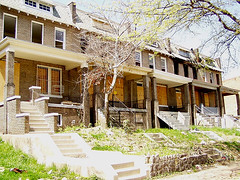 Mothballing properties. Photo by Elise Bernard.
Mothballing properties. Photo by Elise Bernard.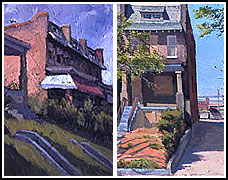 Art in neglect. Brett Busang's "Steep Stair, 3rd Street," left, and "Along 3rd" were painted on the west side of the 1000 block of Third Street in Northeast Washington.
Art in neglect. Brett Busang's "Steep Stair, 3rd Street," left, and "Along 3rd" were painted on the west side of the 1000 block of Third Street in Northeast Washington.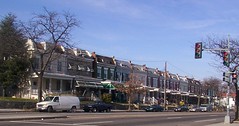 Maintained "S-type" rowhouses in Petworth. Photo from BeyondDC.
Maintained "S-type" rowhouses in Petworth. Photo from BeyondDC.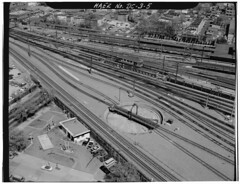 Photo from the Historic American Engineering Record, available online from the Library of Congress. (HAER, DC,WASH,559-5. RAIL YARD BEHIND UNION STATION. WASHINGTON, D.C.)
Photo from the Historic American Engineering Record, available online from the Library of Congress. (HAER, DC,WASH,559-5. RAIL YARD BEHIND UNION STATION. WASHINGTON, D.C.)While doing some image research I came across these paintings of some scenes from Downtown DC. Enjoy.
 Sarah Pollock: Waiting to Cross, Downtown D.C., 2003. 12 x 15 1/2. Pastel on paper. Downtown D.C. at the Farragut North Metro Station during the evening rush hour.
Sarah Pollock: Waiting to Cross, Downtown D.C., 2003. 12 x 15 1/2. Pastel on paper. Downtown D.C. at the Farragut North Metro Station during the evening rush hour. Sarah Pollock: In This Moment, Downtown D.C. 2004. 22 x 17. Pastel on paper. Near the Farragut North Metro Station during a warm summer evening in the city of Washington, DC.
Sarah Pollock: In This Moment, Downtown D.C. 2004. 22 x 17. Pastel on paper. Near the Farragut North Metro Station during a warm summer evening in the city of Washington, DC.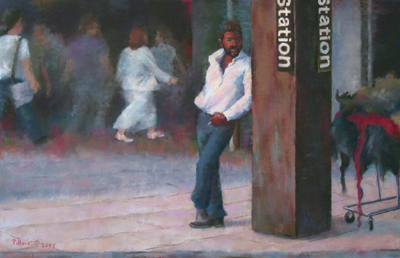 Sarah Pollock: Homeless, Downtown D.C. 2003. 16 3/4 x 10 1/4. Pastel on paper.
Sarah Pollock: Homeless, Downtown D.C. 2003. 16 3/4 x 10 1/4. Pastel on paper.
 Photo by Elizabeth Conley, The Detroit News. Lisa LaVallis of Bloomfield Township backs her township library's stance against issuing cards to nonresidents.
Photo by Elizabeth Conley, The Detroit News. Lisa LaVallis of Bloomfield Township backs her township library's stance against issuing cards to nonresidents.Last fall, there was a "defeat" in the creation of an historic district in the greater Tenleytown area. I learned about this from the H-DC email list, which linked to the website of the historic designation opponents. Given that tomorrow there is a meeting about the Comprehensive Plan and historic preservation, it's worth putting up my response to this from last fall.
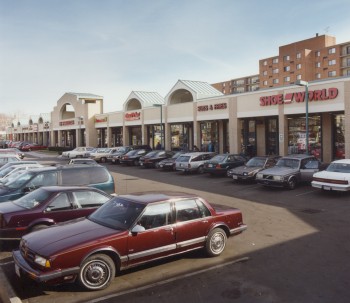 Your tax dollars at work--urban-renewal-based economic development in Northeast Washington, DC.
Your tax dollars at work--urban-renewal-based economic development in Northeast Washington, DC.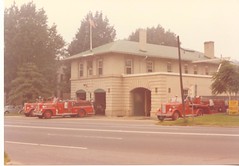 Engine House 20 in more historic times.
Engine House 20 in more historic times.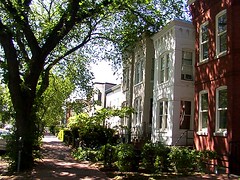 Rowhouses on Capitol Hill.
Rowhouses on Capitol Hill. This "fan light" door, much nicer than the average store-bought door used by renovators in DC, is by and large not an historically accurate choice for DC homeowners.
This "fan light" door, much nicer than the average store-bought door used by renovators in DC, is by and large not an historically accurate choice for DC homeowners.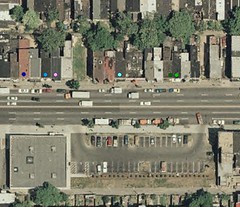 On the top of this aerial photo of the 1200 block of H Street, buildings eligible for historic designation are visible, while on the south side, such buildings were torn down, to be replaced by a cinder-block Autozone store and parking lot.
On the top of this aerial photo of the 1200 block of H Street, buildings eligible for historic designation are visible, while on the south side, such buildings were torn down, to be replaced by a cinder-block Autozone store and parking lot.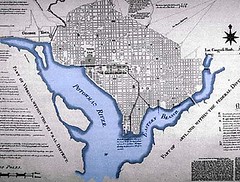 A good read for today, again by Donovan Rypkema, is "Planning the Future, Using the Past: The Role of Historic Preservation in Building Tomorrow's Washington, DC" . (Another great paper by Rypkema is "Affordable Housing and Historic Preservation: The Missed Connection".
A good read for today, again by Donovan Rypkema, is "Planning the Future, Using the Past: The Role of Historic Preservation in Building Tomorrow's Washington, DC" . (Another great paper by Rypkema is "Affordable Housing and Historic Preservation: The Missed Connection".
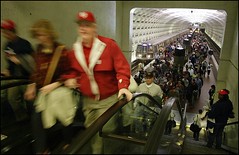 People using the subway to go the home opener for the Washington Nationals. Photo from the Washington Post.
People using the subway to go the home opener for the Washington Nationals. Photo from the Washington Post._______
 I find that "Funky Winkerbean" and the related "Crankshaft", comic strips that run in the Washington Times, tend to have some pretty good commentary about "Main Street" and customer service type issues.
I find that "Funky Winkerbean" and the related "Crankshaft", comic strips that run in the Washington Times, tend to have some pretty good commentary about "Main Street" and customer service type issues. No local newspaper runs "Lucky Cow," a comic strip set in the workplace of a fast food restaurant (the Washington Post considered it but chose not to, instead they have "Pearls before Swine" which is hit or miss, but distributed by the Washington Post Writers Group) but I like it.
No local newspaper runs "Lucky Cow," a comic strip set in the workplace of a fast food restaurant (the Washington Post considered it but chose not to, instead they have "Pearls before Swine" which is hit or miss, but distributed by the Washington Post Writers Group) but I like it.
The DC Energy Office promotes energy conservation, but seems to have a low profile (although I did see a car wrapped in a DC Energy Office logo recently).
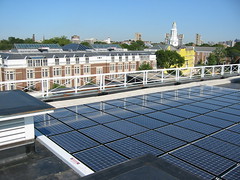 Solar panels on top of Harvard Business School Fitness Center. This project was supported by funds from the MTPC program.
Solar panels on top of Harvard Business School Fitness Center. This project was supported by funds from the MTPC program.
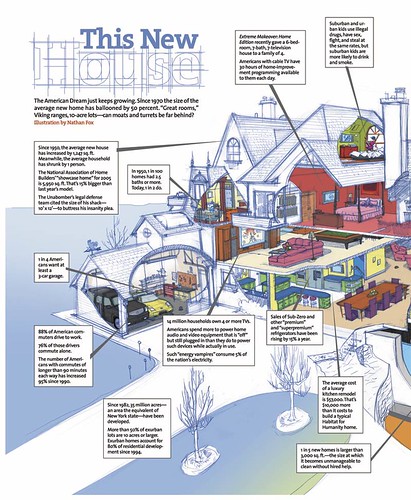 From "This New House," in the March/April issue of Mother Jones magazine.
From "This New House," in the March/April issue of Mother Jones magazine.Of course, since there is this upcoming meeting, there has been some discussion about some of the issues. The agenda for the meeting seems pretty packed. I hope we can get to some of the meaty issues. Here's an email that I sent around on some, but only some, of my thoughts on this.
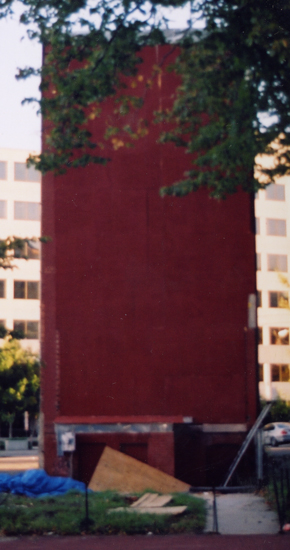 The developer, Trammell Crow?, ripped off the facade of the building at 439 Massachusetts Avenue NW. The permit for this rape of a facade called it an "alteration." Photo by Peter Sefton.
The developer, Trammell Crow?, ripped off the facade of the building at 439 Massachusetts Avenue NW. The permit for this rape of a facade called it an "alteration." Photo by Peter Sefton.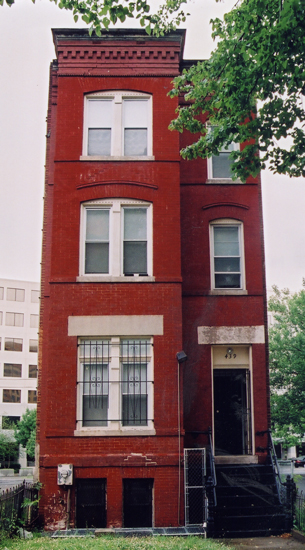 439 Massachusetts Avenue NW in happier times. Photo by Peter Sefton.
439 Massachusetts Avenue NW in happier times. Photo by Peter Sefton.The San Diego Union-Tribune reports that Mayor Dick Murphy is resigning: "SAN DIEGO – Amid recall demands by the city attorney and a week after being named by Time magazine as one of the three worst big-city mayors in the United States, Mayor Dick Murphy announced he will resign effective July 15."
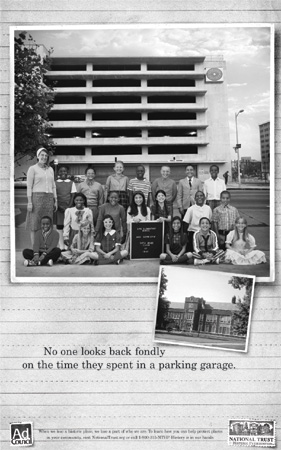 From the "History is in our Hands" campaign from the National Trust for Historic Preservation.
From the "History is in our Hands" campaign from the National Trust for Historic Preservation.Steve Morris writes:
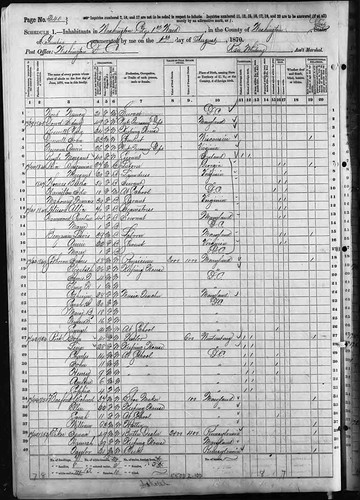 A Census enumeration sheet for Washington County, District of Columbia, 1870. Image from Rootsweb.com.
A Census enumeration sheet for Washington County, District of Columbia, 1870. Image from Rootsweb.com.On the pro-urb list, there is a thread, still, about the gentrification article that ran in USA Today, based on the work of Columbia University Professor Lance Freeman. It reminded me of something that came up in the testimony about DC Main Street.
In testimonies to the Zoning Commission (for the H Street Neighborhood Commercial District Overlay) and to the DC City Council Committee on Economic Development (about the DC Main Streets program), I submitted a document picturing various signs on H Street, to make the point about the necessity of sign guidelines as part of the overlay for the former, and for the necessity of design review in Main Street districts for the latter testimony. (Here's a related blog entry from last month.) The last two images are new.
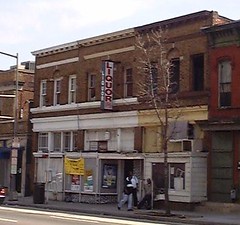
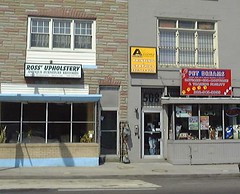

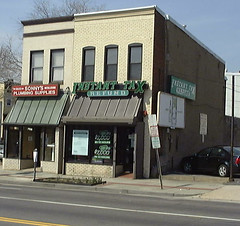
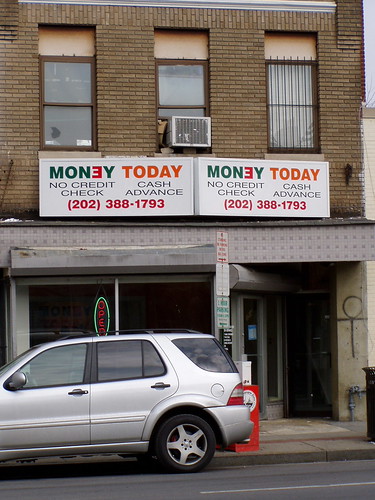

 '
'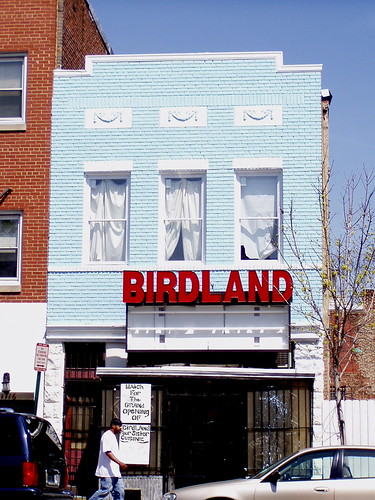
Labels: urban design/placemaking
Yesterday, the City Council Committee on Economic Development held a hearing on funding for the DC Main Streets program, which for a time was in jeapordy, because the funding source originally provided is now fully tapped out.
• High-quality community leadership, including residents and stakeholders at all levels; who are
• Committed to working together, despite the existence of pre-existing, possibly competitive organizations; and are
• Committed to implementing and following the Main Street Approach;
• Securing of additional financial support to supplement and extend the impact of monies awarded by the DC Government;
• Enlightened property owners;
• Business proprietors that know what they are doing;
• DDOT investment in and upgrading of the streetscape (a significant infrastructure investment greater than $8 million); and
• the fortuitous implementation of the Capitol Hill BID to provide daily cleaning and maintenance on the newly constructed sidewalks and streets of Barracks Row.
(It strikes me that the Mayor's "Great Streets" initiative is but a repackaging and extension of the great strides that the DC Department of Transportation is making throughout the city to recenter our "main" streets and commercial districts towards the resident and the pedestrian as opposed to a focus on helping cars, usually driven by commuters, in and out of the city as fast as possible. But implementation at the ground level, without using the ground-up citizen asset-based approach that the Main Street Approach is all about, should be of great concern.)
Skipping over the key investment in infrastructure that Barracks Row experienced, it is clear that their commitment to the Main Street model, to resident and stakeholder volunteers, based on a quality base of property owners and business owners is essential.
Unfortunately too many people throughout the city, the Main Street model is but one more in a long line of community revitalization programs, no better or no worse than any other.
The Barracks Row experience demonstrates that, with commitment to and implementation of the model that the Main Street program is (or can be) truly different, and successful in the face of myriad failures throughout the decades in this city, and across the country. (I have testified before City Council a number of times about these failures, as typified by the experience of community development corporations in this city and the use of CDBG monies.)
The Main Street districts that are having difficulties are not likely to share the success factors that make Barracks Row Main Street a contender for this year's "Great American Main Street" designation, which will be awarded at next month's National Main Street conference.
One of the difficulties is a failure to ensure that other District government agencies are equally committed to the development of exemplary programs and projects.
In 2003, I provided an extended testimony to the DC Department of Housing and Community Development, which discussed how a lack of concern on achieving quality in various CDBG projects actually reduced the likelihood of successful neighborhood revitalization. This is certainly the case on H Street, where in the past few years, close to $2 million has been expended on run of the mill efforts that have contributed little to the revitalization of the corridor, meanwhile the H Street Main Street program was working with less than $150,000 over the same period of time. (The testimony also focused on the execrable design of the new HSCDC constructed building at 721-727 H Street NE.)
The City of Cleveland has created a zoning overlay called a "Business Revitalization District" to "...ensure appropriate design of buildings, signage, and property in business areas targeted for concentrated improvements. More specifically, it is the purpose of this [zoning] chapter to achieve among others, the following objectives:
a) To preserve jobs, tax revenues and local services through the upgrading of business districts;
b) To safeguard the public investment in revitalization through prevention of inappropriate signage and property design in business areas targeted for concentrated public improvements and rehabilitation financing: and
c) To protect residential and commercial property values, particularly for businesses and residents committing private funds to rehabilitation in designated revitalization areas (Ord. No. 1664-88. Passed 10-3-88, eff. 10-6-8)."
This reasoning seems indisputable. Scarce economic resources, and in places where investment can be risky, requires that we ensure that property design, construction, and signage is created that meets the highest standards of quality urban design. (In any case, it is the opinion of this writer that all projects in the city, regardless of location, should attempt to achieve the best urban design standards and expectations, following the intentions of both the original L’Enfant Plan for the City of Washington, and its "successor," the McMillan Commission in 1901.)
High standards can best be attained through the application of design guidelines and careful project review. In fact, projects funded by various agencies of the DC Government, and in particular the DC Department of Housing and Community Development ,should set the standard for "appropriate design of buildings, signage, and property in business areas targeted for concentrated improvements." These projects have significant impact in neighborhoods throughout the city, and it is imperative to ensure that they are uniformly excellent!
This is particularly true on H Street NE, which is the fortunate beneficiary of a great deal of public investment –the Main Street program, the development of the H Street Strategic Development Plan by the Office of Planning, the Transportation Enhancement Program initiated by the DC Department of Transportation, and other programs, in addition to significant amounts of private investment. However, the same argument holds true for every neighborhood in the city.
In the testimony to DHCD, I made a number of recommendations that the City Council needs to consider with the aim of ensuring that public and private investments truly work together to bring about true community revitalization.
Recommendation 1: That the publication Thrive: A Guide to Storefront Design in the District of Columbia, produced by the DC Office of Planning, provides excellent design guidelines for property owners, and that projects funded with DC Government monies or federal monies administered by the DC Government, including all projects initiated by DHCD, should treat the Thrive guidelines as REQUIREMENTS to ensure quality design and improvements that truly forward the objectives of commercial district revitalization.
Recommendation 2: That DHCD create a set of design guidelines to be used in the development and execution of all renovation, rehabilitation, and construction projects undertaken, licensed, or funded, in whole or in part, by the agency.
Recommendation 3: That, as part of the contract agreement between grantees, DHCD, and the Government of the District of Columbia, and as a condition of receiving funding, all grantees of projects funded in whole or in part by DHCD shall be required to adhere to design guidelines and related requirements to ensure the production of quality projects that contribute positively to community and commercial revitalization in the District of Columbia.
Recommendation 4: That for designated DC Main Streets communities, Mayor Williams promulgate an Executive Order holding all Executive Agencies of the Government of the District of Columbia responsible for ensuring that agency policies, programs, and actions are implemented in concert with Main Street precepts for successful commercial district revitalization. This shall be done in consultation with the DC Main Streets office and individual Main Street programs throughout the city.
Recommendation 5: That, when the design guidelines are created by DHCD as a result of Recommendation 2 above, Mayor Williams promulgate an Executive Order holding all Executive Agencies of the Government of the District of Columbia responsible for adopting the guidelines, and incorporating them into all agency projects involving renovation, rehabilitation, or construction, including contracts with third parties.
Creating a companion "Revitalization District" law, to ensure appropriate design of buildings, signage, and property in business areas targeted for concentrated improvements be it through the DC Main Streets or other ReSTORE DC programs, through the new "Great Streets" or "New Communities" initiatives, or other programs, is as necessary to the Main Street program as its continued funding, and I hope that you will consider adding this to your Committee's agenda.
Thank you.
ARRGH--Flickr, my photo database, is down until late tonight, so I will have to insert the photographs tomorrow. I guess I will just put them in a separate entry. RL